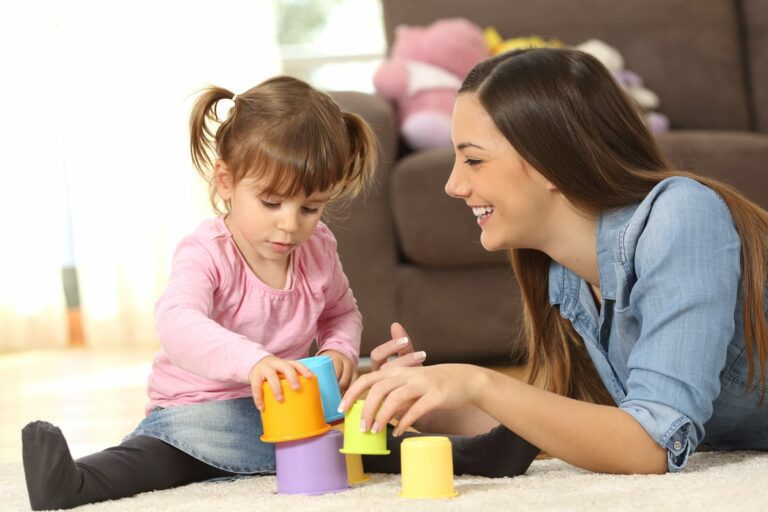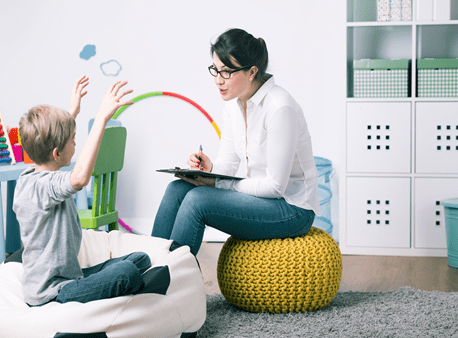Hi there! My name is Courtney and I’m a pediatric speech-language pathologist (SLP). I absolutely love my job and helping children find their voice. In my short, but busy almost three years of being an SLP, I have had the pleasure of working with children with all different types of profiles, strengths, and needs. Why am I writing a blog about children with Autism Spectrum Disorder (ASD) you might ask? Because one of my absolute favorite diagnoses to work with is this population. Children with Autism are fascinating and amazing to me. I love seeing how their minds work and finding individualized methods that will help them progress. The thing is, no one person with Autism is the same as the next. It’s all about cracking into how they see the world and finding what works for them. And boy, when they break the commonly thought of ASD characteristics with examples such as hugging you and telling you they love you, or asking if you are okay when you are sad or sick, it is truly an amazing thing to experience, and it is possible!
So what exactly am I trying to help you with today? I want to help families communicate with their children who have Autism and are partly or fully non-verbal. If you are wondering how to communicate more easily with your child or how to help them be less frustrated and subsequently demonstrate decreased behavioral challenges than this article is for you! Maybe you are hoping someday your child will be fully verbal, or you hope that they will be social and have friends. These are all very common questions and concerns that I want to help you navigate!
The following are ways to help support your child:
- First and foremost, if you have not done so already, have your child evaluated by a speech-language pathologist and find out if they are appropriate and could benefit from speech and language therapy. I’d recommend asking your child’s pediatrician to refer you to a speech-language pathologist that they recommend or a simple Google search for SLP’s in your area can help get the process started. It might also be beneficial to ask your child’s school to complete a speech and language evaluation to determine if he / she can benefit in the school setting.
- It is likely that your child may benefit from speech and language therapy in school and/or privately. Once your child is working with a therapist, talk to your therapist about implementing Alternative and Augmentative Communication(AAC) and whether or not that would be appropriate for your child. As speech and language pathologists, our first goal is to develop a way for your child to effectively communicate. This means that if they are non-verbal and not able to speak in words, we need to find an alternative method for them to express their wants, needs, etc. That is exactly what AAC is. It’s an alternative method for people to communicate. For some, this includes pointing to picture icons to show you what they want, for others they may use a device such as an iPad to select icons that speak what they would like to communicate. AAC is not necessarily permanent and it does not mean that your child will never develop verbal skills. Ideally, AAC and verbal therapy will be worked on in conjunction and frequently the use of AAC can actually help increase children’s verbal skills.
- Similarly to having your child evaluated by a speech-language therapist at school, find out how they are doing at school and if they need any additional supports. For example, if your child is struggling in school, perhaps they need an Individualized Education Plan (IEP). They might benefit from specific modifications and accommodations that tailor to your child’s individual needs such as providing them visual supports with verbal instructions. It’s also wise to think about whether they are in the appropriate classroom setting. Some things to consider include what type of instruction their current classes provide, what is the student/teacher ratio, what type of curriculum do they follow, and do the other students in the class have similar profiles?
- Talk and play with your child as much as possible! Children learn how to communicate from hearing adult models. So as much as possible, if you are with your child, you want to be talking to them so they can hear what you do and eventually try to imitate you. Similarly, play is also very important. Play skills are foundational for language development. So any chance you get, play with your child! Also, encourage them to interact and play with peers as well. Frequently, children with ASD tend to prefer adult interaction and have more difficulty interacting with peers. Their social skills will become stronger with more practice, so encourage them to communicate with peers!
- Create opportunities for your child to have to communicate! This means that if you are serving them a snack, maybe only give them 3 goldfish and then wait until they communicate to you (however that may be-gestures, words, picture icons) before giving them anything else. Another example is if you are leaving to go somewhere and you need to open the door. Instead of just opening the door, intentionally leave it closed until your child communicates to you that you need to open it.
- Children with Autism learn through multiple modalities and there are many types of learners. This means that simply hearing something verbally will likely not be enough for your child to understand. Provide them as many visuals and written language (if they can read) as possible to increase their ability to understand.
- When your child does communicate (nonverbally or verbally without using negative behaviors (crying, screaming), positively reinforce it! For example, if they do sign “more” to tell you they would like more goldfish, provide them the goldfish and tell them “I love that you showed me you wanted more!” This will allow your child to recognize that they did something positive and that they should continue to do so.
- If your child is in speech and language therapy, try to collaborate with their therapist to find out what they are working on in therapy and what you can do to help at home. The most important piece of therapy is your child being able to take what they can do in the session and apply it to their daily life and outside of the speech and language room. You can expedite this process by practicing their new skills at home!
- It’s easy to just assume that your child needs or wants something and to get/do it for them without them telling you. However, we are not always correct in assuming what our children want and often times that is why children might demonstrate negative behaviors (they feel frustrated and powerless because someone is guessing incorrectly what they are trying to tell us). Also, we want our children to become more independent communicators and that cannot happen if we don’t allow them those powerful opportunities to communicate to us.
Thanks for taking the time to listen to my suggestions, I hope they help!





